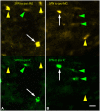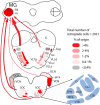Subcollicular projections to the auditory thalamus and collateral projections to the inferior colliculus
- PMID: 25100950
- PMCID: PMC4103406
- DOI: 10.3389/fnana.2014.00070
Subcollicular projections to the auditory thalamus and collateral projections to the inferior colliculus
Abstract
Experiments in several species have identified direct projections to the medial geniculate nucleus (MG) from cells in subcollicular auditory nuclei. Moreover, many cochlear nucleus cells that project to the MG send collateral projections to the inferior colliculus (IC) (Schofield et al., 2014). We conducted three experiments to characterize projections to the MG from the superior olivary and the lateral lemniscal regions in guinea pigs. For experiment 1, we made large injections of retrograde tracer into the MG. Labeled cells were most numerous in the superior paraolivary nucleus, ventral nucleus of the trapezoid body, lateral superior olivary nucleus, ventral nucleus of the lateral lemniscus, ventrolateral tegmental nucleus, paralemniscal region and sagulum. Additional sources include other periolivary nuclei and the medial superior olivary nucleus. The projections are bilateral with an ipsilateral dominance (66%). For experiment 2, we injected tracer into individual MG subdivisions. The results show that the subcollicular projections terminate primarily in the medial MG, with the dorsal MG a secondary target. The variety of projecting nuclei suggest a range of functions, including monaural and binaural aspects of hearing. These direct projections could provide the thalamus with some of the earliest (i.e., fastest) information regarding acoustic stimuli. For experiment 3, we made large injections of different retrograde tracers into one MG and the homolateral IC to identify cells that project to both targets. Such cells were numerous and distributed across many of the nuclei listed above, mostly ipsilateral to the injections. The prominence of the collateral projections suggests that the same information is delivered to both the IC and the MG, or perhaps that a common signal is being delivered as a preparatory indicator or temporal reference point. The results are discussed from functional and evolutionary perspectives.
Keywords: binaural; brain evolution; lateral lemniscus; medial geniculate nucleus; paralemniscal area; parallel pathways; reticular formation; superior olive.
Figures













Similar articles
-
The auditory brainstem nuclei and some of their projections to the inferior colliculus in the North American opossum.Neuroscience. 1983 Dec;10(4):1203-32. doi: 10.1016/0306-4522(83)90109-4. Neuroscience. 1983. PMID: 6664491
-
Anatomical projections of the nuclei of the lateral lemniscus in the albino rat (Rattus norvegicus).J Comp Neurol. 2009 Feb 1;512(4):573-93. doi: 10.1002/cne.21929. J Comp Neurol. 2009. PMID: 19034907
-
The nuclei of the lateral lemniscus: unexpected players in the descending auditory pathway.Front Neuroanat. 2023 Aug 9;17:1242245. doi: 10.3389/fnana.2023.1242245. eCollection 2023. Front Neuroanat. 2023. PMID: 37621862 Free PMC article.
-
Anatomy and physiology of binaural hearing.Audiology. 1991;30(3):125-34. doi: 10.3109/00206099109072878. Audiology. 1991. PMID: 1953442 Review.
-
Parallel auditory pathways: projection patterns of the different neuronal populations in the dorsal and ventral cochlear nuclei.Brain Res Bull. 2003 Jun 15;60(5-6):457-74. doi: 10.1016/s0361-9230(03)00050-9. Brain Res Bull. 2003. PMID: 12787867 Review.
Cited by
-
Multiple Sources of Cholinergic Input to the Superior Olivary Complex.Front Neural Circuits. 2021 Jul 15;15:715369. doi: 10.3389/fncir.2021.715369. eCollection 2021. Front Neural Circuits. 2021. PMID: 34335196 Free PMC article.
-
Abnormal morphology and subcortical projections to the medial geniculate in an animal model of autism.Exp Brain Res. 2021 Feb;239(2):381-400. doi: 10.1007/s00221-020-05982-w. Epub 2020 Nov 16. Exp Brain Res. 2021. PMID: 33200290
-
Neural population encoding and decoding of sound source location across sound level in the rabbit inferior colliculus.J Neurophysiol. 2016 Jan 1;115(1):193-207. doi: 10.1152/jn.00643.2015. Epub 2015 Oct 21. J Neurophysiol. 2016. PMID: 26490292 Free PMC article.
-
Leveling up: a long-range olivary projection to the medial geniculate without collaterals to the central nucleus of the inferior colliculus in rats.Exp Brain Res. 2022 Dec;240(12):3217-3235. doi: 10.1007/s00221-022-06489-2. Epub 2022 Oct 22. Exp Brain Res. 2022. PMID: 36271940
-
Olivocochlear projections contribute to superior intensity coding in cochlear nucleus small cells.J Physiol. 2022 Jan;600(1):61-73. doi: 10.1113/JP282262. Epub 2021 Dec 6. J Physiol. 2022. PMID: 34761815 Free PMC article.
References
-
- Adrian H. O., Goldberg J. M., Brugge J. F. (1966). Auditory evoked cortical potentials after lesions of brachium of inferior colliculus. J. Neurophysiol. 29, 456–466 - PubMed
-
- Angelucci A., Clasca F., Sur M. (1998). Brainstem inputs to the ferret medial geniculate nucleus and the effect of early deafferentation on novel retinal projections to the auditory thalamus. J. Comp. Neurol. 400, 417–439 10.1002/(SICI)1096-9861(19981026)400:3<417::AID-CNE10>3.0.CO;2-O - DOI - PubMed
Grants and funding
LinkOut - more resources
Full Text Sources
Other Literature Sources

